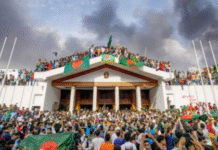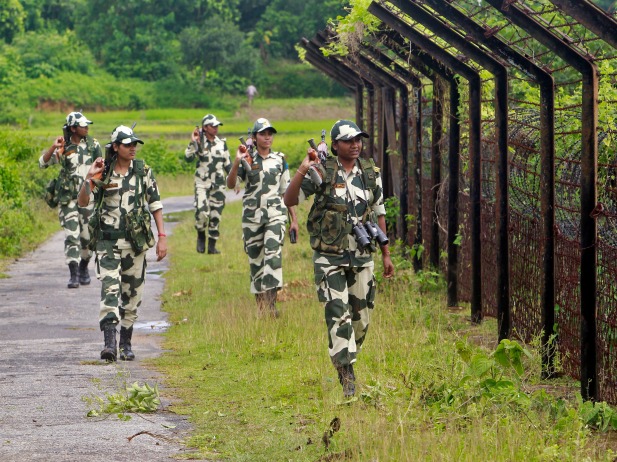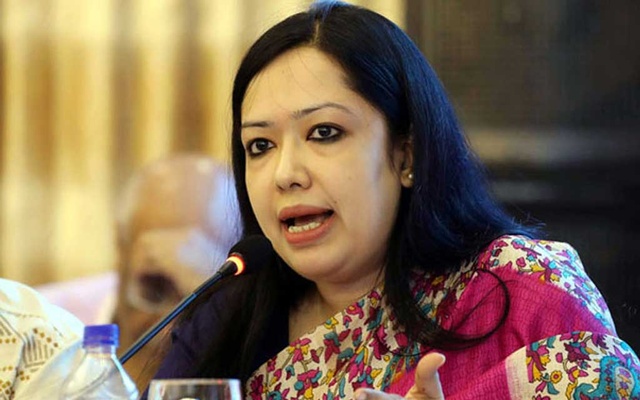TBS

Bangladesh stood witness to a gruesome incident in Goalanda, Rajbari district, on 5 September 2025, when a mob descended upon the shrine of Nurul Haque, known locally as Nural Pagla, a self-proclaimed spiritual leader who had passed away just weeks earlier. What unfolded was not mere vandalism but an act of grotesque barbarity: the crowd exhumed his body from the grave, dragged it to the Dhaka-Khulna highway, and burned it.
One person, 28-year-old Russel Molla, was killed in the ensuing chaos, while at least 22 others—including a journalist—were injured. Police and army personnel were present, yet they stood by as the frenzy unfolded, their vehicles vandalised and officers pelted with stones.
The government’s response has been a strongly worded press release condemning the act as “abhorrent” and “heinous”, vowing “immediate and tough legal action”. Yet, as police filed a case against 3,500 unidentified individuals the next day, and even though seven people have been arrested, the lead perpetrators—allegedly linked to local Jamaat-e-Islami and Bangladesh Nationalist Party (BNP) leaders—remain at large.
This pattern of strong words followed by a chronic lack of enforcement has become the hallmark of the interim administration under the Chief Adviser Muhammad Yunus.
The World Sufi Organisation reported 80 attacks on mazars (shrines) in the six months prior to January 2025, with a similar number in the ensuing period.
The police’s inactivity is nothing short of criminal negligence. In Goalanda, law enforcement was on site yet failed to intervene effectively, allowing the mob to desecrate the grave and burn the body over a prolonged period.
This mirrors incidents elsewhere: on the same day, a shrine in Rajshahi’s Paba upazila was vandalised by around 150 people, with police—who had two vehicles deployed nearby—doing nothing to stop it.
Human rights activist Nur Khan Liton said, “Issuing condemnation after any incident, instead of preventing it from happening in the first place, shows the weakness of the government. The body was burnt over a prolonged period. There were political leaders behind the mob. Justice is needed now.”
Khan’s words ring true. The interim government has issued at least 13 condemnations in its 13 months—roughly one per month—covering everything from shrine attacks to assaults on political offices and desecration of the national flag. Yet, in over 20 such incidents, no meaningful action has followed.
Hefazat-e-Islam, an Islamist group, condemned the body-burning as “unacceptable” but blamed the administration for not addressing local grievances earlier, highlighting how even critics point to governmental inertia. And all the major political parties also joined the condemnation; yet no reflection on the field.
This inaction fuels the mob frenzy. Veteran journalist Kamal Ahmed wrote in his Facebook profile: “The responsibility of political parties in the Goalanda incident is not insignificant either. The local political leaders who incited tension 24 hours before the grave vandalism and body burning should face action from their central leadership; failure to do so would be self-destructive. When Islam does not permit criticism of the deceased, it is inappropriate to label violent attackers as ‘Tawhidi masses’. Under the country’s existing penal code, desecration of graves or bodies is identified as a criminal offence, though the punishment is minimal. Therefore, the law needs amendment. A one-year jail term for such crimes is hardly effective.”
The interim government’s mandate was to stabilise the country post-uprising, yet mob rule has intensified, with 80% of Bangladeshis expressing concern over rising violence in a July 2025 survey done by the Voice for Reform and the Brac Institute of Governance and Development (BIGD).
Mobs do not appear out of nowhere. There are agitators—leaders who are organising the mob. As far as the last incident in Goalanda is concerned, the agitations were brewing over a few days. There could have been more police deployment, even army deployment. There are many ways to control the crowd without firing. We have not seen such measures.
Kamal Ahmed further said, “A few months ago, I wrote that the interim government’s problem lies in its inaction when it comes to preventing untoward incidents. Their activity is more evident in condemning, investigating, and arresting after crimes and violence occur, but if this proactive approach had been taken earlier, much damage could have been avoided. It does not seem that they realise the far-reaching harm caused by such reactive behaviour. The inhumane frenzy in Goalanda has once again proven this point.”
Barrister Sara Hossain, a prominent human rights activist, has pointed out the fact that the authorities and the police are unable to take preventive measures against such mob violence.
“Mobs do not appear out of nowhere. There are agitators—leaders who are organising the mob. As far as the last incident in Goalanda is concerned, the agitations were brewing over a few days. There could have been more police deployment, even army deployment. There are many ways to control the crowd without firing. We have not seen such measures.”
Shafiqul Alam, press secretary to the chief adviser of the interim government, said, “We are taking actions against the mob. Arrests are being made. Seven people have been arrested already. The police are active, and they tried to control the situation there. However, the crowd grew too large to be contained. They became violent and unruly, and attacked police and civil service officers. We are taking actions against the people who broke laws.”
Here, the necessity of more effective preventive measures becomes evident.
“Why does the government wait until 3,000 or 10,000 people gather? Why not stop the agitators and the ringleaders first before they can gather the mob?”, Barrister Sara Hossain asked.
“The ones threatening and organsing the mob are not prevented. We see the government action only after irreparable damage is caused to the victim. Condemnations follow; cases are filed whose fate is never known. Instigating violence or harm to anyone is a crime under our law. The government doesn’t intervene enough when serious threats or instigations of violence are preached. If they could be contained, then such incidents might not have happened.”
Nur Khan Liton added, “The government should have taken preventive measures by talking to the agitators and local authorities. Now, scrutiny is needed to figure out what was lacking on the government’s side. Trying to dodge the question about their failure or shifting the blame on others will be a grave injustice to the people of the country.”
Home Adviser Lt Gen (retd) Jahangir Alam Chowdhury disagreed with the notion that the government are failing to prevent such mobs at a press conference on 7 September:”We have not failed. Those responsible will be brought under the law. The truth is, we have become rather intolerant as a society. There is a growing lack of patience. That is why I urge everyone to remain patient.”
The penal code classifies grave desecration as a criminal offence, punishable by a mere one-year jail term—a penalty Ahmed rightly deems inadequate. But even existing laws go unenforced, emboldening perpetrators.
Experts urge the interim government to move beyond platitudes: deploy proactive policing, fast-track prosecutions, and amend laws to deter such atrocities.
Source : https://www.tbsnews.net/analysis/containing-mob-violence-tall-talk-why-less-action-1230846









